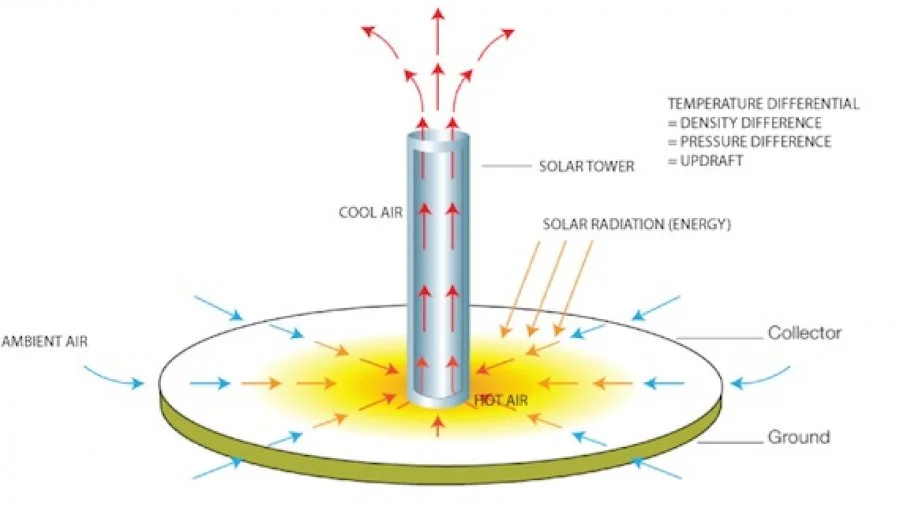Solar Updraft Tower
The solar updraft tower is a renewable-energy power plant for generating electricity from solar power. Sunshine falling on a greenhouse-like collector structure around the base of a tall chimney heats the air within it. The resulting convection causes air to rise up the tower by the chimney effect. This airflow drives wind turbines to produce electricity.
Power output depends primarily on two factors: collector area and chimney height. A larger area collects and warms a greater volume of air to flow up the chimney; collector areas as large as 7 kilometres (4.3 mi) in diameter have been discussed. A larger chimney height increases the pressure difference via the stack effect; chimneys as tall as 1,000 metres (3,281 ft) have been discussed.
- The solar collector area: This can be located in the top part of the chimney or can include the entire shaft. The orientation, type of glazing, insulation and thermal properties of this element are crucial for harnessing, retaining and utilizing solar gains
- The main ventilation shaft: The location, height, cross section and the thermal properties of this structure are also very important.
- The inlet and outlet air apertures: The sizes, location as well as aerodynamic aspects of these elements are also significant.
Solar updraft towers can be combined with other technologies to increase output. Solar thermal collectors or photovoltaics can be arranged inside the collector greenhouse. This could further be combined with agriculture.
Principle
Man learned to make active use of solar energy at a very early stage: greenhouses helped to grow food, chimney suction ventilated and cooled buildings and windmills ground corn and pumped water.
The solar updraft tower’s three essential elements – solar air collector, chimney/tower, and wind turbines – have thus been familiar for centuries, but are combined now in a novel way.
Air is heated by solar radiation under a low circular transparent roof open at the periphery; the roof and the natural ground below form an air collector. In the middle of the roof is a vertical tower with large air inlets at its base. The joint between the roof and the tower base is airtight. As hot air is lighter than cold air it rises up the tower. Suction from the tower then draws in more hot air from the collector, and cold air comes in from the outer perimeter.
Thus solar radiation causes a constant updraft in the tower. The energy contained in the updraft is converted into mechanical energy by pressure-staged turbines at the base of the tower, and into electrical energy by conventional generators.
Fossil fuel prices will continue to rise, as resources are limited and demand is rising rapidly. Solar Updraft Towers today are already directly competitive with oil-fired power plants. Due to rising costs for all fossil fuels including natural gas, they will soon be also competitive with natural gas fired combined cycle plants. The need for carbon-free environmentally benign power generation technologies will further boost the demand for solar power plants.




